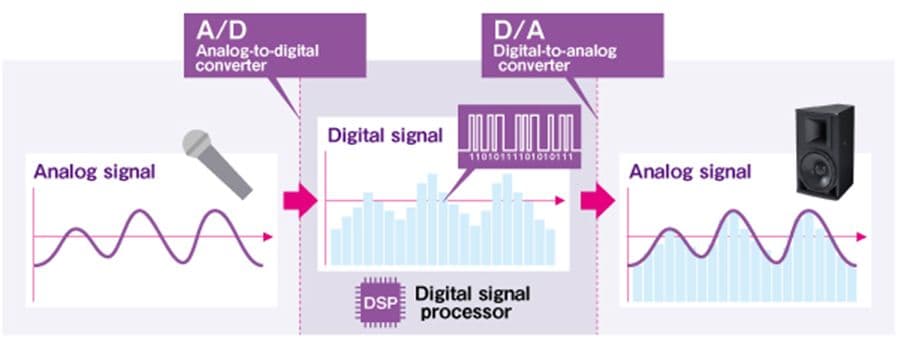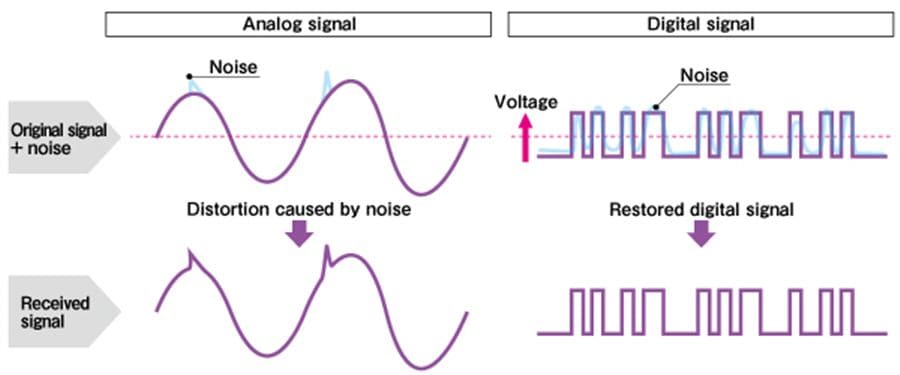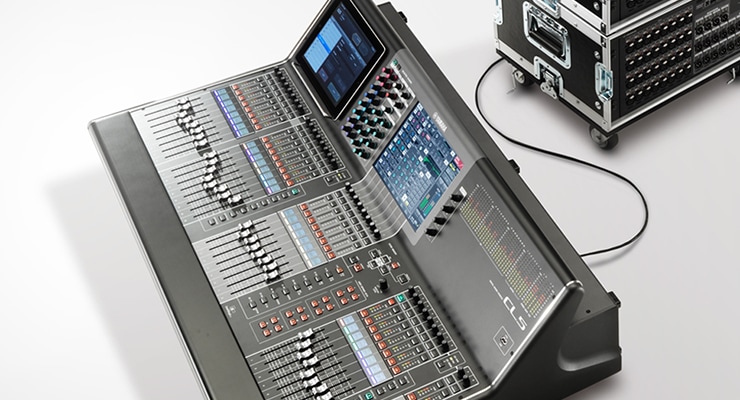Better Sound for Commercial Installations
Part 1: Sound Basics

06. The Merits of Digital Sound
Ever since the CD appeared as the first digital music medium for consumers in the early 80's, digitization of the audio world has progressed steadily. Commercial sound systems are being designed to take advantage of the numerous merits of digital technology as well. Here's a brief summary of the basics of digital audio.
Turning Sound Into Numbers

In digital audio systems, analog audio signals are converted to digital (numeric) data that is then transmitted and processed while in digital form.
(Figure: Digital Audio)
The conversion of analog signals to digital form is known as "A/D conversion." The digital signal that results from that conversion is made up of a series of ones (1) and zeroes (0). Values represented as a series of ones and zeroes are known as "binary" values, as opposed to the "decimal" values made up of the ten numbers from "0" to "9" that we use on a daily basis. Once all necessary signal transmission and processing have taken place and it's time to re-enter the analog domain, the binary digital signal is "D/A converted" back into analog form.
Since sound is basically vibrations travelling through air, as we saw in the "What is Sound?" section, no matter how advanced digital audio becomes the digital audio chain will always have to start and end with analog signals. That's why digital technology is currently concentrated in the mixing and processing stages of the sound system. This leads to the question: "what benefits does using digital technology in only the middle section of the audio chain provide?"
Digital Advantages 1: Repeatability and Immunity to Degradation

Noise is lurking in every stage of any sound system, from the microphone at the input to the speakers at the output. And wherever there are long cable runs there's a chance that more noise will infiltrate the system causing distortion of the signal. This is the same for both analog and digital systems. The difference is that once an analog signal has been degraded by noise, the change is irreversible and the output from the system will be distorted. Digital signals, on the other hand, are made up of ones and zeroes represented by a voltage that is simply above or below a given reference level. Noise may cause minor changes in the voltage, but as long as the "above" or "below" relationship with the reference level remains unchanged, the ones and zeroes are still recognizable as ones and zeroes so the underlying signal remains unaffected. For this reason digital sound systems are much more resistant to noise than analog systems, even where long cable runs are used, and they exhibit greater immunity to signal degradation.
(Figure: Susceptibility of Analog and Digital Signals to Noise)
Digital Advantages 2: Easy operation and Automation
The ability to memorize and recall settings whenever they are needed is another digital benefit. For a banquet room or event space, for example, you might have basic settings for dinners, meetings, presentations, and other events pre-programmed so that they can be recalled in an instant. With the basic settings already prepared, all you have to do is make any necessary minor adjustments. Compared to setting up the entire system from scratch for each event, this can save a significant amount of time and effort.
Digital systems can also automatically suppress feedback and compensate for volume variations if a speaker doesn't maintain a constant distance from the microphone, for example. A variety of previously tricky tasks are being made easier or fully automated by advanced digital technology.
Digital Advantages 3: Multiple Functions in a Single Device
Like computers, digital audio devices function according to programs. So a wide range of functionality can be implemented in a single device by providing the appropriate programs. We'll touch on this subject again in "Processing Types" in Part 3, but for now we'll just consider the basic benefit of this capability, which is that the number of devices required for a complete system can be reduced, and that results in reduced purchase, installation, and maintenance cost, while allowing powerful systems to be installed in a relatively small amount of space.
Digital Advantages 4: Expandability and Connectivity
This merit is related to those described in the preceding paragraph. Unlike analog devices that have fixed functions, the programs used in digital devices can be modified during installation to accommodate changes in the system design, or to make improvements or allow expansion once the system is complete. Digital devices can also be linked to external computers or touch-panel control systems, for example, that allow easy access and control. Custom interfaces can be designed to make it easy for inexperienced operators to make necessary adjustments. Digital mixers and processors that support plug-in expansion cards make it possible to increase the number of available inputs and/or outputs in a variety of analog and digital formats. This means, for example, that you can use existing analog processors in your new digital system, further enhancing flexibility and reducing overall cost.
In the preceding six sections of "Part 1 - Sound Basics" we have covered the basics of sound and sound systems, and looked at some of the advantages provided by digital technology. In Part 2 we'll go into some detail about actual devices and hopefully introduce some points that will contribute to a great-sounding commercial installation.
Contents
The sound systems that broadcast the information you're hearing have been carefully designed and installed to suit the needs of each individual facility.
This series offers information aimed at achieving the best possible sound in commercial installations, from the basics to equipment selection and day-to-day operation.








